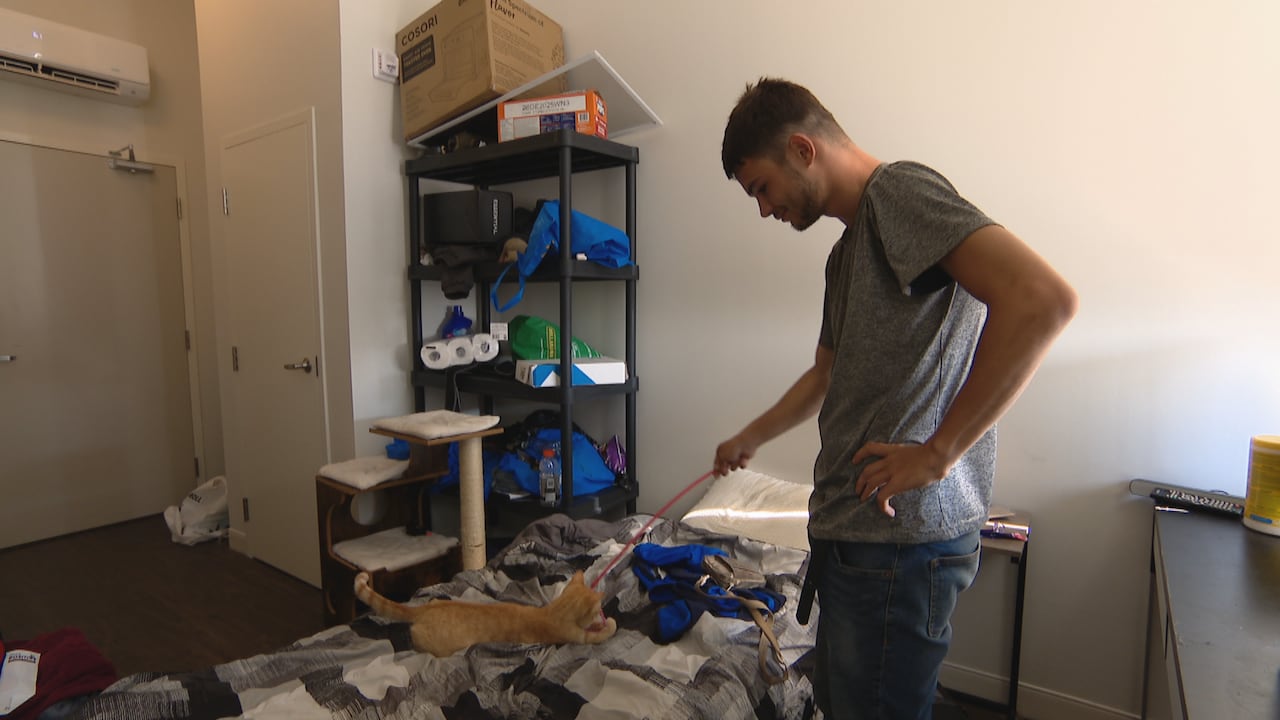Ronan Henneberry says affordable housing saved his life. He’s lived with his cat in The Refuge, a youth outreach centre in Oshawa, since May.
“I have, for once in my life, choices,” he said.
“I have options. I can do things where I don’t have to worry about being homeless.”
Henneberry lives in one of 26 units inside a former school building. The apartments range in size from 150 to 200 square feet, each equipped with a kitchenette, private bathroom and internet access.
The Refuge launched its affordable housing project in May, responding to what the mayor of Oshawa has called a homelessness crisis in the city. Close to 500 people are homeless in Oshawa, according to data from July, and around 1,000 people in Durham Region overall.
Youth have been priced out of the housing market and are dealing with deteriorating mental and physical health, says Clarence Keesman, executive director at The Refuge.
“Something had to be done,” he said.
Residents at The Refuge pay $425 a month, which amounts to their housing benefit under Ontario Works or the Ontario Disability Support Program, he said.
The program lasts four years and is renewable for as long as the resident needs. Keesman says he’s seen youth enrolled in shorter, non-renewable programs panicking when the program is set to expire.
“They still can’t afford anything, and then they exit into homelessness once again,” he said.
Beyond the affordable housing program, The Refuge also provides meals, access to laundry facilities, showers, recreational programs, counselling and housing guidance.
Last year, the centre had its busiest year in two decades, Keesman said.
“It’s all linked to affordability of housing. Because if people can’t find a place to live, what do you do? Where do you go?” he said.
Connecting housing starts and homelessness
The units at The Refuge are a drop in the bucket compared to the need for housing in Oshawa.
About 70 per cent of Ontario’s 50 largest municipalities missed their provincial housing targets in 2024 — including Oshawa, which reached half of its goal. It’s not looking better this year: Oshawa has met 25 per cent of its 2025 target so far.
Updated numbers show the Ontario government once again failed to meet its goal for housing starts, even with new ways of counting them. CBC’s Lorenda Reddekopp has the details — and reaction.
For Oshawa to meet its target of building 23,000 new homes between 2022 and 2031, the city would need to build more houses than it has done in the past 30 years, the city said in an emailed statement to CBC News.
But there is not a simple connection between housing targets and homelessness, says Tyler Frederick, associate professor at Ontario Tech University’s faculty of social science and humanities.
While more housing is needed across the board, he says it has to be the “right kind of housing” – affordable rental housing — to have a meaningful impact on people who are homeless.
“Part of it is having clear housing plans or clear ideas about the housing that’s most needed, and making sure that there’s a spectrum of housing,” he said.
600 affordable housing units in the works for Durham
The City of Oshawa told CBC News it has taken “significant steps” to remove barriers and support housing supply, including fast-tracking approvals for affordable and purpose-built rental housing.
That’s being done amid plans to create 600 affordable housing units in Durham Region. This includes redevelopments on Christine Crescent and Normandy Street in central Oshawa that are set to begin next year, depending on federal housing funding, the region said in an email.

Work is also underway to see if another former Oshawa school building — Ritson Public School — could partly be turned into mixed-income rental housing, the region said.
Oshawa Mayor Dan Carter says the city is continuing to work with the region to provide affordable housing. But he says there need to be ways of combining housing with services that help people who are struggling with mental health and addictions.
“How do we take people from being unsheltered to independence? That takes a pattern of strategic investments and initiatives to actually do,” he said.
During his time as president of Durham Region Non-Profit Housing Corporation, he says he worked to bring residents programs like Rogers Connected for Success, which provides affordable high-speed internet plans. He says these are the types of initiatives he wants to see more of.

(Jason Trout/CBC)
“It makes people uncomfortable because they think we should just provide them housing and that’s it and walk away,” Carter said.
Meanwhile, Henneberry says there need to be more spaces like The Refuge across Durham Region that are safe and provide the reassuring security of a lease.
He says he’s heard dozens of stories of people struggling to find places to stay for the night. One of his friends walked from Oshawa to Ajax in hopes of getting space at a shelter.
“That’s just torture to me, making someone walk three cities and you don’t even know about their past, if they have disabilities,” he said.
“And then if you show up … you may not even have a bed for the night.”







